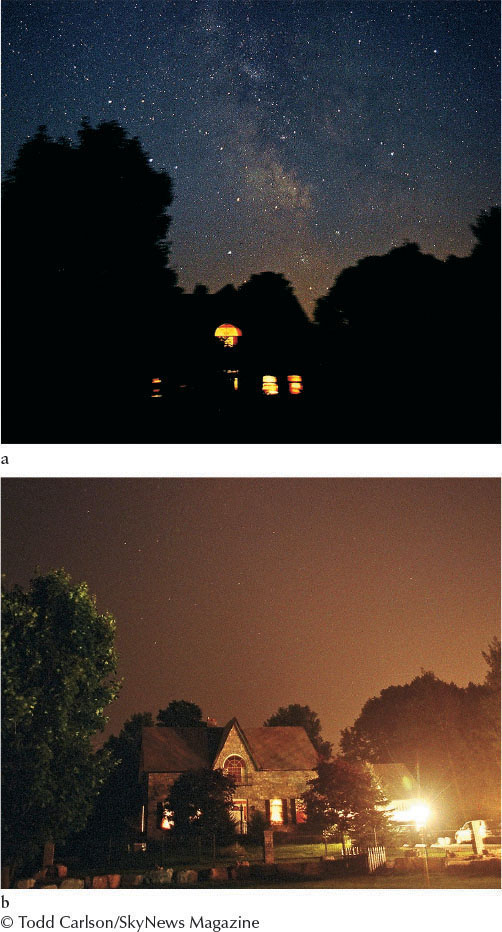5
CHAPTER [strong]1[/strong]

Discovering the Night Sky
WHAT DO YOU THINK?
 Is the North Star—Polaris—the brightest star in the night sky?
Is the North Star—Polaris—the brightest star in the night sky?
 What do astronomers define as constellations?
What do astronomers define as constellations?
 What causes the seasons?
What causes the seasons?
 When is Earth closest to the Sun?
When is Earth closest to the Sun?
 How many zodiac constellations are there?
How many zodiac constellations are there?
 Does the Moon have a dark side that we never see from Earth?
Does the Moon have a dark side that we never see from Earth?
 Is the Moon ever visible during the daytime?
Is the Moon ever visible during the daytime?
 What causes lunar and solar eclipses?
What causes lunar and solar eclipses?
Answers to these questions appear in the text beside the corresponding numbers in the margins and at the end of the chapter.
6
You are studying astronomy at an exciting time as astronomers draw open the curtains of the cosmos. Our understanding of the cosmos (or the universe) and how it evolves is growing as never before. That is due, in large measure, to the immense light-gathering power and sensitivity of modern telescopes. Current telescope technology makes it possible for astronomers to observe objects that were completely invisible to us just a few years ago. For example, we can now see so far away and therefore so far into the past that we see the first stars and the first galaxies as they just began forming more than 13½ billion years ago. We could not see these objects even a decade ago, and likewise, it took just 21 years for astronomers to discover 1000 planets orbiting nearby stars, a feat that would have been impossible 30 years ago.
Telescopes are not the only means by which we are deepening our understanding of what lies beyond Earth’s atmosphere. We have also begun the process of physically exploring our neighborhood in space. In just the past half century, humans have walked on the Moon; space probes have roamed over parts of Mars, dug into its rocks and soil, and blasted its surface with laser beams; and other probes have crashed into one comet and brought back debris from another one, landed on an asteroid and on murky Titan, discovered active volcanoes and barren ice fields on the moons of Jupiter, traveled through the shimmering rings of Saturn, and departed from the realm of the planets in our solar system, to mention just a few accomplishments. We are also witnessing the dawn of space tourism, with people buying trips to the International Space Station.
In the best locations, the night sky is truly breathtaking (Figure 1-1a). Even if you cannot see the thousands of stars visible in clear locations (Figure 1-1b), software such as Starry Night™ can show them to you. The night sky can draw you out of yourself, inviting you to understand what is happening beyond Earth and inspiring you to think about our place in the universe.

Until the past few centuries, the explanations people found for what they saw in the sky were based on beliefs that had to be accepted on faith—there was no way to test ideas of what stars are, or whether the Moon really has liquid water oceans (as was believed back then but is not true), or how the planets move, or why the Sun shines. Times have changed. We are fortunate to be living in an era when science has answers to many of the questions inspired by the universe.
Beautiful, intriguing, and practical, astronomy and its ongoing process of discovery have something for everyone. This course and this book will help you better understand the universe by sharing what we have learned and are still learning about many of these questions. They will also demonstrate the awesome power of the human mind to reach out, to observe, to explore, and to comprehend. One of the great lessons of modern astronomy is that by gaining, sharing, and passing on knowledge, we transcend the limitations of our bodies and the brevity of human life.
In this chapter you will discover
 how astronomers map the night sky to help them locate objects in it
how astronomers map the night sky to help them locate objects in it
 that Earth’s spin on its axis causes day and night
that Earth’s spin on its axis causes day and night
 how Earth’s orbit around the Sun combined with the tilt of Earth’s axis of rotation relative to its orbit create the seasons
how Earth’s orbit around the Sun combined with the tilt of Earth’s axis of rotation relative to its orbit create the seasons
 that the Moon’s orbit as seen from Earth creates the phases of the Moon and lunar and solar eclipses
that the Moon’s orbit as seen from Earth creates the phases of the Moon and lunar and solar eclipses
 how the year is defined and how the calendar was developed
how the year is defined and how the calendar was developed
7